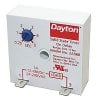bricklayer
- Jun 11, 2016
- 10
- Joined
- Jun 11, 2016
- Messages
- 10

OK, here’s what I came up with.
This system uses two relays, two contactors and the pressure switches to monitor the system for high or low pressure conditions.
It should be noted that this circuit was designed specifically for the Dwyer A1PS-44 High pressure cut-off switch. Other switches may be used, but they must operate in the exact same fashion.
As a side note, I’d wire your pumps for 220V if possible. They’ll start easier, run better and a little cooler if you do.
Circuit description:
The main power switch provides power for the entire circuit.
Pressing the LP Start switch will energize relay K2. Once energized, K2 will self-latch, arm the low pressure switch and provide power to the LP pump contactor which turns on the LP pump.
If using a standard Low pressure switch such as the Square D (http://www.homedepot.com/p/Square-D-...21CP/100199433) the switch will activate immediately providing power to the high pressure Start switch. If using the Dwyer A1PS-24/34 pressure switch (http://www.dwyer-inst.com/Product/Pr...-A1VS#ordering) the high pressure Start button receives power only after the minimum pressure is reached.
When minimum pressure is achieved on the high pressure side, the high pressure switch will activate. This activation will energize relay K1. Power for both pumps is now maintained through K1, and K2 will de-energize which will prevent an unintended restart during a fault condition.
Fault detection:
Prior to achieving minimum system pressure on the high pressure side, the low pressure switch controls power to the high pressure pump. Any problems with developing low pressure will prevent the high pressure pump from starting. Once minimum system pressure is obtained, both the high and low pressure switches are in series providing a latch to K1. Either a too high or too low pressure event will de-latch K1 and shut the system down.
Pressure switch settings and considerations:
Both pressure switches have minimum and maximum settings.
If using the Dwyer Low pressure switch, the switch minimum should be set to about 5 psi below system running pressure as measured on the low pressure side with the high pressure pump running and needle valve fully open. If using the Square D type, minimum pressure setting can be ignored.
The maximum setting for either switch type must be set higher than the maximum pressure the low pressure pump can obtain. When selecting a low pressure switch, check the specifications on the pump you are using to determine its maximum pressure.
The high pressure switch minimum should be set as low as possible. Hopefully this is low enough to activate with the needle valve fully open. The maximum, or cut-off value, is set to your preference.
Design limitations:
This design is very basic to keep costs down. As a result, there are a couple of minor things I did not address.
First- At main power turn on there is a small chance that the high pressure pump may briefly start. It shouldn’t last more than 1/100th of a second though and shouldn’t cause any damage.
Second- If the high pressure switch minimum setting can’t be set low enough, you’ll need to stand there and hold the high pressure start switch while closing the needle valve until you have enough system pressure to activate the switch. The “High Pressure” lamp will tell you when you can let go.
Third- As the high pressure switch activates relay K1 will energize. There will be a very brief moment when power will be lost to both pump contactors so you may hear a slight dip in pump RPM as K1 and K2 change states. Again, this should only last about 1/100th of a second.
Fourth- Electromagnetic Interference (EMI). There’s a lot of arcing and sparking going on as relays and contactors open and close, magnetic fields are generated as the coils of these devices are powered and de-powered. These actions cause spikes and potential operational interference in the form of what we call transients. If this were a digital circuit, prevention/suppression of transients would be mandatory. Generally speaking, relays and contactors aren’t usually susceptible to this type of interference and transient suppression isn’t needed for this circuit. More to the point, however, is that these transients will propagate throughout the AC lines in your shack, meaning that other devices, like your smart phone or laptop (if plugged in and charging), may exhibit some strange behavior. Charging power supplies for your electronics, if of good quality, can normally handle these transients, but best to leave these type of devices unplugged while the RO is running. Additionally, that digital alarm clock you’ve got plugged in out there is probably going to give you the ole stink-eye every time you fire that RO up.
Parts:
Relays- The relays, at a minimum, need to have a 110V coil and the contacts should be rated for at least 5 amps. Any meeting those requirements are fine, but I prefer DIN mount such as these:
http://www.ebay.com/itm/JQX-13F-110-...0AAOSwjVVVifJx
The DIN mount makes mounting and wiring easier and much cleaner.
Of course, if using the DIN mount, you’ll need the rail:
http://www.ebay.com/itm/NEW-DIN-RAIL...IAAMXQCgpRuz8o
Last edited:


